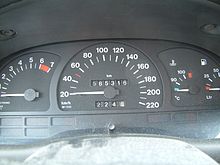Opel X16SZ
The X16SZ is an engine of Opel and was built from 1993 to 1996.
Technical specifications
- 4-stroke gasoline engine
- Design: OHC 4 cylinders in line
- Displacement: 1.6 l / 1598 cm³
- Stroke × bore: 81.5 × 79 mm
- Camshaft drive: toothed belt
- Camshaft opening angle: 254 °
- Number of valves: 8
- Output: 52 kW (71 PS) at 5000 rpm.
- Torque: 128 Nm at 2800 rpm.
- Compression: 10.0: 1
- Emission standard: fulfills EG96 (D3)
- RON fuel requirement : 91 octane / 95 octane
- Catalytic converter : regulated catalytic converter
- Engine management: Multec-SZ
- Gearbox : F13
Engine designation nomenclature
| Abbreviation | meaning |
|---|---|
| X | D3 emission standard |
| 16 | Cubic capacity × 100 in cm³ |
| S. | Compression between 9.5: 1 and 10: 1 |
| Z | Central injection |
| Abbreviation | meaning |
|---|---|
| R. | Version with increased performance |
| C. | EURO1 emissions standard |
| N | Compression between 9: 1 and 9.5: 1 |
| Z | Central injection |
| E. | Single injection |
durability
The engine is generally considered to be very robust. The reason for this is the engine block, which is also used in the unchanged design in more powerful engine variants. One example is the C16SE engine, which offers multi-point injection (Multec-M) instead of single point injection (Multec). This engine delivers up to 74 kW (101 hp) and puts more stress on the engine block. In the less powerful X16SZ variant, this results in a longer shelf life due to the lower mechanical and thermal stress.
history
X16SZ the engine was installed Astra F and Vectra A .
It was already available in 1987 in the Kadett E and Ascona C , and in 1988 in the Corsa A , but as the C16LZ (from model year 1988 C16NZ) with a poorer emissions rating (Euro 1) and higher output (55 kW).
The X16SZ had a 3 Nm higher torque (128 Nm and 125 Nm in the C16NZ ). It ensured acceleration values from 0 to 100 km / h in 14 and 15 seconds , respectively . The top speed was 170 km / h in the Astra and 173 km / h in the Vectra.
production
The engine was produced from 1993 to 1996 with the aim of reducing emissions. The next evolution of this engine can be found in X16SZR (55 kW) again in the Vectra B , Astra F and Astra G was used. Production ended in 2000 due to increased demands on emissions standards, which could no longer be met with central injection.
Further development
In October 2000, the Z16SE was introduced, which still had the same engine block. This engine is equipped with a multi-point injection system, which enabled an emissions standard of D4. The output has been increased to 62 kW (84 hp). This engine was used in the Astra G, Meriva and Combo.
Performance improvements
Well-known manufacturers have tuning packages ready for the X16SZ and X16SZR, which increase the performance. The spectrum ranges from sports air filters to camshafts and forged pistons to complete engines suitable for racing.
